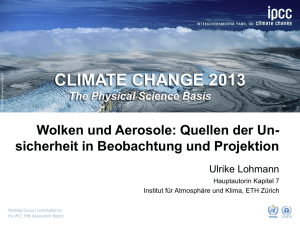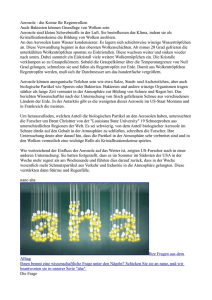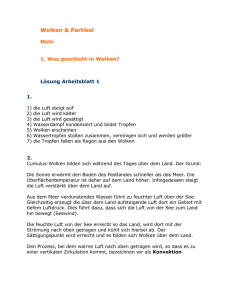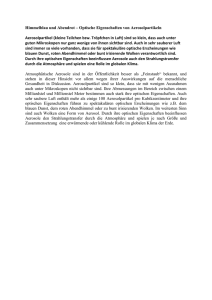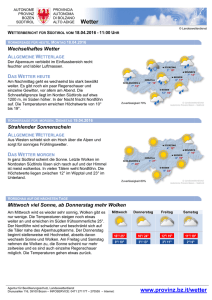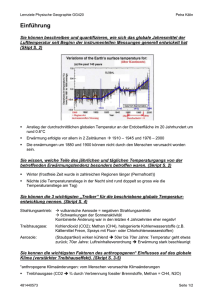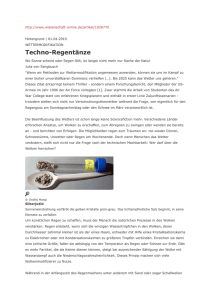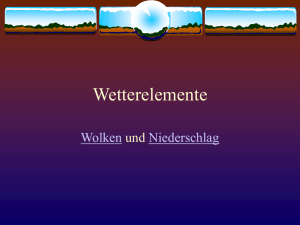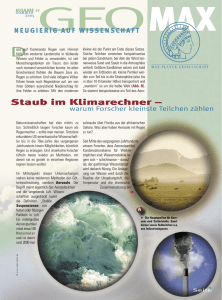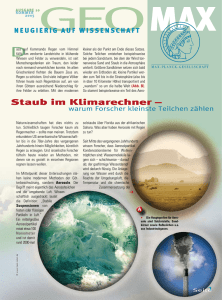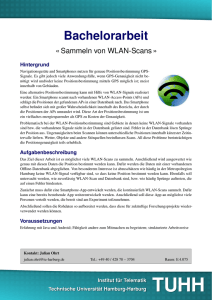CLIMATE CHANGE 2013
Werbung
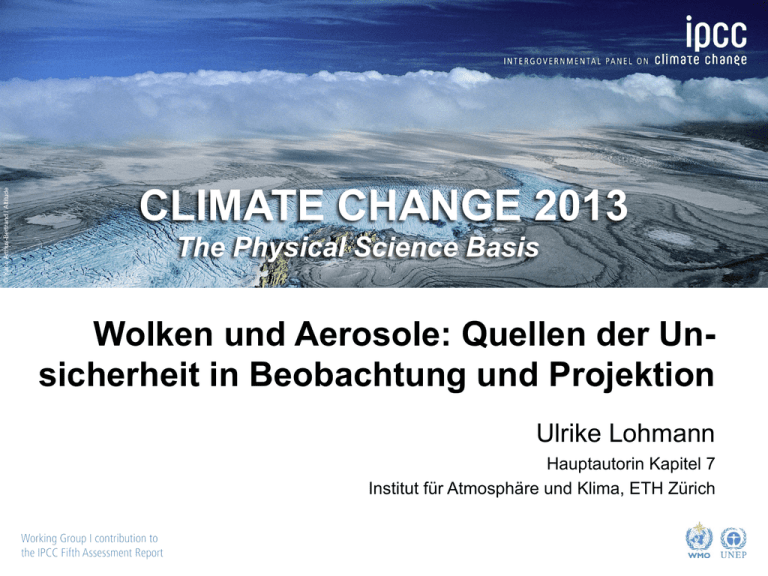
© Yann Arthus-Bertrand / Altitude CLIMATE CHANGE 2013 The Physical Science Basis Wolken und Aerosole: Quellen der Unsicherheit in Beobachtung und Projektion Ulrike Lohmann Hauptautorin Kapitel 7 Institut für Atmosphäre und Klima, ETH Zürich Was ist neu? • Wolken und Aerosole haben ein eigenes Kapitel im 5. Zustandsbericht • Geoengineering als mögliche Option zur mittelfristigen Stabilisierung des Klimas durch Beeinflussung der Solarstrahlung wird diskutiert Inhaltlich: • Grösstenteils Bestätigung des 4. Zustandsberichts • Sicherere Aussagen dank verbesserter Datenlage und Darstellung von Wolken und Aerosole in Klimamodellen und besserem Prozessverständnis • Weiterhin unsicher: Rolle der Wolken bei der globalen Erwärmung und Strahlungsantrieb der Aerosole Beobachtete Temperaturänderung 1850-2012 Observed globally averaged combined land and ocean (a) surface temperature anomaly1850–2012 0.6 Annual average 0.4 Anomaly (°C) relative to 1961-1990 0.2 0.0 -0.2 -0.4 -0.6 0.6 Decadal average 0.4 0.2 0.0 -0.2 -0.4 AR5, SPM, Fig. 1 -0.6 1850 1900 Year 1950 2000 Strahlungsantrieb der Aerosole Short Lived Gases and Aerosols Anthropogenic Well-Mixed Greenhouse Gases Emitted Compound Radiative Forcing by Emissions and Drivers CO2 1.68 [1.33 to 2.03] VH CH4 CO2 H2Ostr O3 CH4 0.97 [0.74 to 1.20] H Halocarbons O3 CFCs HCFCs 0.18 [0.01 to 0.35] H N 2O N 2O 0.17 [0.13 to 0.21] VH CO CO2 CH4 O3 0.23 [0.16 to 0.30] M NMVOC CO2 CH4 O3 0.10 [0.05 to 0.15] M NOx Nitrate CH4 O3 −0.15 [−0.34 to 0.03] M −0.27 [−0.77 to 0.23] H Cloud Adjustments due to Aerosols −0.55 [−1.33 to −0.06] L Albedo Change due to Land Use −0.15 [−0.25 to −0.05] M 0.05 [0.00 to 0.10] M Aerosols and precursors Mineral Dust Sulphate Nitrate Organic Carbon Black Carbon Changes in Solar Irradiance 2011 Total Anthropogenic RF relative to 1750 −1 AR5, SPM, Fig. 5 Level of Confidence CO2 (Mineral dust, SO2, NH3, Organic Carbon and Black Carbon) Natural Resulting Atmospheric Drivers 2.29 [1.13 to 3.33] H 1980 1.25 [0.64 to 1.86] H 1950 0.57 [0.29 to 0.85] M 0 1 2 3 −2 Radiative Forcing relative to 1750 (W m ) Strahlungsantrieb der Aerosole AR5, TS, Fig.6 Strahlungsantrieb der Aerosole Irradiance Changes from Aerosol-Radiation Interactions (ari) Direct Effect Radiative Forcing (RFari) Semi-Direct Effects Adjustments Effective Radiative Forcing (ERFari) AR5, WGI, Kapitel 7 Irradiance Changes from Aerosol-Cloud Interactions (aci) Cloud Albedo Effect Lifetime (including glaciation & thermodynamic) Effects Radiative Forcing (RFaci) Adjustments Effective Radiative Forcing (ERFaci) AR4 AR5 Radiative forcing due to aerosol-radiation interactions 2 AeroCom mean AeroCom 5%−95% range Bellouin et al. (2013) RFari (Wm-2) 1 Su et al. (2013) 0 −1 −2 AR5, WGI, Chapter 7 60 ºS 30 ºS Eq Latitude 30 ºN 60 ºN Rückkopplungsmechanismen bei einer CO2 Verdopplung additional feedbacks: +0.2 K +0.6K ??? albedo feedback cloud feedback +1.0 K water vapor +lapse rate feedback Doubling of atmospheric CO2 +1.2 K initial warming (Planck feedback) + +1.8 K +3 K (1.5-4.5K) Total warming Strahlungswirkung von Wolken Hohe Wolken: wärmen Tiefe Wolken: kühlen Antwort der Wolken auf eine globale Erwärmung Rising High Clouds Broadening of the Hadley Cell Narrowing of Tropical Ocean Rainfall Zones Rising High Clouds Poleward Shift of Storms Rising of the Melting Level More Polar Clouds Less Low Clouds Equator AR5, WGI, Kapitel 7 30º 60º Pole Antwort der Wolken auf eine globale Erwärmung CMIP5 Feedback (W m-2 ºC-1) 1.5 CMIP3 CFMIP LW CFMIP & CMIP3 Models (by cloud level) 1.0 SW Net CFMIP Models (by cloud property) 0.5 0.0 -0.5 -1.0 AR5, WGI, Kapitel 7 Total High Middle Low Amount Height Opacity Geoengineering Quelle: Miriam Kübbeler (2012) Change in T BNU-ESM HadCM3 CanESM2 HadGEM2-ES CCSM4 IPSL-CM5A-LR CESM-CAM5.1-FV MIROC-ESM EC-Earth MPI-ESM-LR GISS-E2-R NorESM1-M Ensemble Mean Change in Temperature (°C) (a) 3.0 2.5 2.0 1.5 1.0 0.5 0.0 -0.5 cipitation (mm day-1) (b) 0 10 20 0.10 0.08 0.06 AR5, 0.04 WGI, Kapitel 7 0.02 0 30 40 50 60 0.5 0.0 -0.5 (b) Change in Precipitation (mm day-1) Geoengineering 1.0 70 0 10 20 30 40 50 60 70 0 10 20 30 40 Year 50 60 70 0.10 0.08 0.06 0.04 0.02 0 -0.02 -0.04 -0.06 -0.08 Geoengineering Temperatur Niederschlag AR5, Fig. 7.23 Wichtigste Aussagen: • Wolken stellen mit 66% Wahrscheinlichkeit eine positive Rückkopplung dar • Der Strahlungsantrieb der Aerosole seit vorindustrieller Zeit fällt mit -0.9 Wm-2 (Unsicherheitsbereich von -1.9 Wm-2 bis -0.1 Wm-2) weniger negativ aus als im 4. Klimabericht • Sonnenlicht-Geoengineering kann zu einer Abkühlung führen, aber nicht gleichzeitig sowohl die Temperaturals auch die Niederschlagsänderung kompensieren. Zudem steckt es noch in den Kinderschuhen, ist ungetestet und mit zahlreichen Nebenwirkungen und Risiken verbunden © Yann Arthus-Bertrand / Altitude CLIMATE CHANGE 2013 The Physical Science Basis Further Information www.climatechange2013.org
